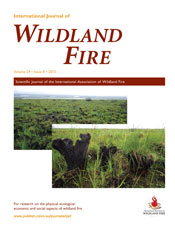International Journal of Wildland Fire
Volume 24
Number 8 2015
Wildfires can significantly degrade air quality and cause a health hazard to exposed human populations. The amount and type of pollutants in wildfire smoke are strongly influenced by the fuel characteristics and the burning conditions. Public health response to wildfire smoke relies on knowledge of the main pollutants present in the smoke, the intensity and duration of exposure and the dispersion of the smoke plume.
A multidecadal analysis of fire in Alaskan Arctic tundra shows the average size of tundra fire based on the data record is 22 km2 (5454 acres). Warmer and drier summers are expected to increase fire activity. Implications of arctic fire are discussed in the context of land management and ecosystem services.
This study compares the accuracy of optical and radar sensors for fire severity estimation. Overall, the results show that optical sensors are more accurate. However, for some forest types radar sensors achieve similar accuracies. Combining synthetic aperture radar and optical data improved fire severity estimation for all forest types.
This paper shows the potential for seasonal prediction of above-normal fire activity in a Mediterranean region (north-eastern Spain), driving a parsimonious statistical model with antecedent drought (with a time delay of 2 years) and with drought conditions just before the start of the fire season.
This study presents results from laboratory experiments of backing fires with slope and wind in fuel beds of Pinus pinaster Ait. needles and straw. Rate of spread, flame geometry and wind penetration into the fuel bed were assessed and the influence of several parameters on fire behaviour was analysed.
We investigate the causes and spatial patterns of wildfire ignitions. The majority of wildfires are due to the action of humans and the spatial pattern is strongly influenced by population density. In future years, more ignitions are predicted due to population increases and climate change effects.
While ribbon bark eucalypt is notorious for igniting spotfires many kilometres ahead of a bushfire, no research has shown that such firebrands can sustain combustion for the time required. It was found that Eucalyptus viminalis bark samples burning in a vertical wind tunnel could theoretically travel more than 20 km.
Physical characteristics of southern Ontario’s tallgrass prairie fuel complex were assessed prior to and during prescribed burns to synthesise findings into useful tools for the prescribed-burn community. These characteristics include fuel load, heat of combustion, rates of spread and flame front residence time.
Spatial variation in surface fine fuel moisture content (FFMC) due to topographic aspect and vegetation can be very large and important when predicting burn outcomes in mountainous landscapes. Modelling capacity, however, is limited by over-simplistic equations for below-canopy radiation and insufficient spatial FFMC data for evaluating model performance.
Through combustion experiments and leaf trait measurements, we discovered that south-eastern Amazonian tree species demonstrate substantial variability in their relative flammability. Leaf morphology accounted for a significant proportion of this variability. Our results illustrate a potentially important relationship between species-level flammability, future fire behaviour and subsequent forest composition.
Severe fires accelerate rock weathering by spalling and exfoliation, both during the fire and during the subsequent cooling of the rocks. Chalks are the most affected type of carbonate rocks, owing to the laminated structure of the overtopping ‘Nari crust’. Three years after the fire, the rocks continue to break down internally. Wildland fires may serve as extremely important factors of denudation.
This article presents research on the development and initial testing of a new scale to measure desired leadership specific to wildland firefighting. Findings revealed a three-factor structure of leadership; initial evidence supported a psychometrically sound and relevant tool for practical application in the wildland fire environment.




